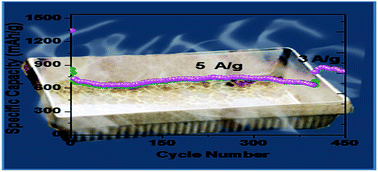Metal–organic framework-combustion: a new, cost-effective and one-pot technique to produce a porous Co3V2O8 microsphere anode for high energy lithium ion batteries†
Abstract
A porous, cobalt vanadate (Co3V2O8) microsphere electrode with a cubic crystalline phase is synthesized using a novel one-pot synthesis with a metal–organic framework (MOF) based combustion strategy for use in high energy lithium ion batteries. The simple synthesis presented in this paper facilitates the evolution of a porous secondary microsphere morphology from primary aggregates of 20–50 nm particle sizes. This unique morphology appears to be derived from the Co-V–MOF intermediate network formed in situ during synthesis. The Co3V2O8 microsphere electrode displayed excellent cyclabilities at high current densities. In particular, a specific discharge capacity of 940 mA h g−1 after 100 cycles at 1 A g−1 and the highest known capacity of 650 mA h g−1 after 400 cycles at 5 A g−1 are sustained by the prepared microsphere electrode. The enhanced rate performance is mainly attributed to the unique morphology in addition to the nanoscale dimension of the electrode. Ex situ investigations confirmed that the high structural stability of the electrode facilitates minimum volume change during the electrochemical reaction under high discharge/charge rates. Furthermore, the present one-pot synthetic protocol appears to be promising for the production of phase pure, mixed metal oxide nanostructured electrodes for a wide range of applications including energy storage.


 Please wait while we load your content...
Please wait while we load your content...